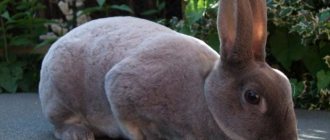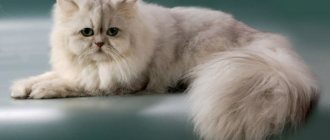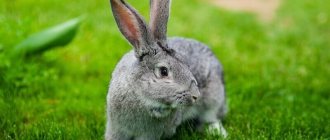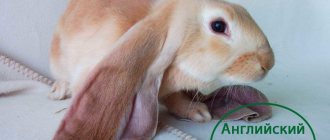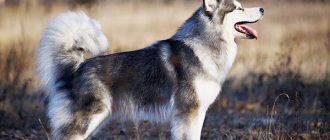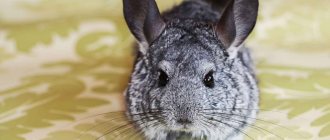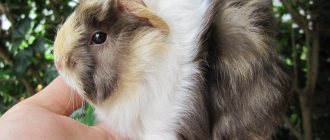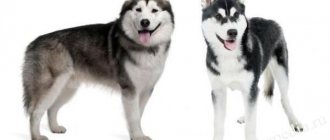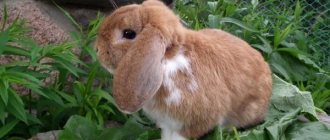Soviet chinchillaSoviet chinchilla is one of the most popular breeds of meat and skin production... - one of the most popular breeds of meat and skin production in the post-Soviet space. In our country, almost all rabbit fur products are made from the fur of these particular rabbits. At the same time, one carcass also produces quite a lot of tasty meat. In general, thanks to all this, chinchilla rabbits. Chinchilla is a rodent from the chinchilla family, which looks like something in between. They are very popular among domestic rabbit breeders.
History of the subspecies
In 1927, American chinchilla rabbits were brought to the USSR for the first time. They were distinguished by their small size and thick fur. After crossing with large breeds, long and targeted selection, it was possible to increase the weight of chinchillas to 5 kg.
The creation of the new breed involved hybrids obtained from crossing rodents - small chinchillas and White Giant rabbits. A new breed, the Soviet chinchilla, was officially registered in 1963.
The authors of the breeds are considered to be the rabbit breeders of two fur-bearing state farms - “Cherepanovsky” (Novosibirsk region) and “Anisovsky” (Saratov region) and specialists from the rabbit farm of the Rabbit Breeding Research Institute (established in 1932).
Description and characteristics of animals
Chinchilla rabbits are a popular breed today for selection and breeding on large rabbit farms. And the history of animals begins in 1910, when in France, by crossing wild animals with domestic ones, a new breed appeared - the common chinchilla. These were small animals with a body weight of 2.5-3 kg.
The description of chinchilla rabbits depends on their species, because over time new species were bred with different, improved qualities. They have their own characteristics, and the general characteristics that are characteristic of chinchilla rabbits are as follows:
- They belong to the meat-skin direction.
- They have high productive qualities: tasty meat, thick fur.
- The coat at the base is gray-blue, and the end of the guide hair becomes black.
- The lower part of the body, tail and inner surface of the limbs are white. The same edging around the eyes.
- Females have fat folds on the chin.
- Short period of growing up.
Based on reviews of chinchillas, we can say that they are smart, calm and friendly animals. Rabbit breeders love them for their unpretentiousness, good maternal qualities of females, and high fertility. In a short time, these animals could form their own rabbit island like the Japanese Okunashima, where tourists would be happy to come to interact with the cute rodents.
Based on reviews of chinchillas, we can say that they are smart, calm and friendly animals.
Description of the breed
Soviet chinchilla belongs to the large category breeds. Chinchilla rabbits are easily recognized by their large size and beautiful fur.
Breed constitution
Main external signs:
- The body is massive, strong and slightly elongated. Length – 60-70 cm. The sternum is massive, rounded, girth – 38-40 cm. The back is long, with a curve.
- The paws are large, strong, fleshy.
- The head, in comparison with the large body, is small and neat.
- The ears are erect and of medium length.
An adult rabbit weighs from 4 to 8 kg. Average weight – 5-6 kg.
Fur and skin
Chinchilla fur is considered one of the most expensive in the world. The Soviet chinchilla has soft and fluffy fur. Color – silver-bluish. There are separate white patches on the belly and in the eye area, and a black border on the top of the tail and on the ears. In the back of the head there is a light wedge. The eyes are usually cherry-brown, but blue can also be seen.
The fur of this breed is unique; it is not only dense and beautiful, but also has a unique color. Today there are a lot of scammers who pass off the fur of these rabbits as expensive chinchilla fur. And this is no wonder, because both furs are thick, shiny, and their color is almost the same.
A distinctive feature of the breed is its heterogeneous color.
Main defects
In a litter there are often rabbits with obvious defects. Such animals are immediately rejected and separated from the herd, since they are not suitable for breeding.
The main defects of the breed include the following:
- drooping croup;
- presence of bald spots;
- uneven fur;
- presence of red color in color;
- back with a hump;
- large ears, drooping and “breaking”.
Character
The character of the Soviet chinchilla is excellent; their behavior is no different from smaller rabbits. They are also kind, sympathetic and love affection. But due to their large size, keeping them at home is too problematic.
Origin
The history of the breed goes back more than 100 years. At the beginning of the last century, French specialists obtained a new type of domestic rabbit with the desired characteristics by crossing representatives of the Russian ermine (Himalayan), Barvenkovsky blue and wild rabbits. The color of the rodent turned out to be unique and very beautiful - gray-blue, and the density of the fur was twice as thick as that of representatives of other species. Both of these qualities made the rabbits similar to a rare and expensive fur-bearing animal - the chinchilla, after which the breeders decided to name the new species.
In 1913, the animals took part in the French Agricultural Exhibition, after which they began to be actively purchased by farms in different European countries.
British breeders also made their contribution and modified the breed by crossing it with giant rabbits, as a result of which the weight of individuals increased to 4 kg.
In the early 20s, Soviet breeders became interested in chinchillas. However, the animals were not adapted to the harsh Russian climate, so the breed began to be adjusted again. For several decades, on the basis of Novosibirsk and Saratov experimental rabbit breeding farms, work was carried out to improve the breed: the animals were intensively fed and crossed with representatives of different species, including white giants.
As a result, the subspecies “Soviet Chinchilla” appeared, individuals of which were perfectly adapted to life in different regions of Russia, had an average weight of 5 kg and valuable fur of a rare color and increased density.
Read the article on the topic: “Features of the Butterfly rabbit.”
Economic characteristics
Soviet chinchillas are bred both in small private farms and on large livestock farms. Rabbits quickly pay for themselves, since the demand for bluish fur and dietary meat is always stable.
Economic characteristics of the breed:
- The average cost of a skin is 3,500 rubles.
- Age for slaughter – 3-4 months.
- Lean meat - suitable for children's and dietary nutrition. The meat has a minimal amount of bones and tendons. Fat contains few calories.
- The cost of sexually mature individuals is 3-4 months old, about 1000 rubles.
Chinchilla skins are readily purchased by felt and fur factories.
If you need advice on how to properly tan a rabbit skin at home, this article can be found here.
Productivity
Large rabbits provide not only valuable bluish fur, but also tasty dietary meat. The cubs gain weight quickly; by six months they gain up to 90-95% of their weight. The main productivity characteristics are in Table 1.
Table 1
| Characteristics | Description |
| Male weight, kg | 6-7 kg, maximum – 8 kg |
| Female weight, kg | 5-6 kg |
| Number of cubs per litter | 7-8 pieces |
| Weight of a 2 month old rabbit | 1.9-2 kg |
| Meat yield at slaughter | 58-60 % |
Giant chinchilla
The giant chinchilla is in many ways similar to the Soviet chinchilla, but giant rabbits are even larger and more powerful. This breed was developed by crossing the silver subspecies with the Flanders.
They have an elongated, rounded body and straight ears. Color – light blue. There are snow-white splashes around the eyes. The lower part of the body is snow-white.
The subspecies is beneficial for breeding. The weight of individuals is 6-7 kg. Maintenance requires spacious cages, plenty of water and food.
Advantages and disadvantages
The breed was bred as a universal breed, so it is slightly inferior to the meat subspecies. But with good feeding, you can quickly fatten up heavy rabbits.
Advantages of the Soviet chinchilla:
- They quickly adapt to different weather and living conditions.
- High productivity in females.
- Due to their large size they produce a lot of meat.
- Fur is highly valued due to its high quality and unusual color. The density of the fur is twice as high as that of other breeds.
Flaws:
- Spacious cages are needed for maintenance.
- Requires a lot of grain and hay for feeding.
- The farm requires significant expenses.
Reviews
According to customer reviews, this breed is classified by most rabbit breeders as universal, although it was originally conceived as a meat-skin breed with an emphasis on the skin direction.
It is, of course, inferior in productivity to pure meat breeds, but with proper adherence to growing technology, chinchilla can provide higher profitability precisely due to the balance of skin and meat products.
As follows from the description of Soviet chinchilla rabbits, their strengths are as follows:
- High quality fur. The hair density of the Soviet chinchilla is 50% higher than that of other breeds. Plus here we need to add the noble gray color, so reminiscent of the very rodent after which the breed is named. All this allows the skins to be successfully sold to processors at a price significantly higher than the cost of skins from other breeds.
- Heavy weight. Due to the fact that chinchilla rabbits grow up to 5 kg, when slaughtered they produce a very large carcass with a lot of meat.
- Undemanding to living conditions. Soviet breeders fully succeeded in creating a very unassuming animal. A chinchilla can be successfully kept in any adequate conditions, eating simple, easily accessible food.
The weaknesses of the chinchilla breed are:
- Small offspring. With an average number of rabbits in one litter of 7-8 pieces (and sometimes only 5-6), the Soviet chinchilla is noticeably inferior in this indicator to many other breeds. Because of this, in order to obtain a large number of young animals, farmers have to maintain a fairly large number of queens.
- Low lethal yield. The meat yield per carcass of a chinchilla is on average 4-5% lower than that of other breeds. At first glance, this is a rather significant figure, but we should not forget that this parameter is more than compensated for by higher quality and more expensive fur.
Content options
The Soviet chinchilla, like other rabbits, can be bred using any of the husbandry methods - aviary, cage or pit. Let's take a closer look at all three options.
In the enclosures
This option is suitable for areas with a mild climate and warm winters. When kept in an enclosure, rabbits can be provided with grazing. The problem with this method of keeping is the behavior of rabbits. They are burrowing animals and can make a dig.
Features of the organization of enclosure maintenance:
- You need a free plot of land covered with grass.
- An awning is pulled over the top to protect from the sun.
- Slate is dug in around the entire perimeter of the enclosure to protect against digging, or the floor is covered with a metal mesh.
- Install side feeders. You can’t pour food on the floor, only into feeders, so that the animals don’t get an intestinal infection.
When kept in an enclosure, you don’t have to clean the cages every day. Disadvantage: uncontrolled reproduction and inbreeding.
In cells
Caging is the best option for breeding rabbits with valuable fur. Advantages of the method:
- Possibility of individual feeding and rational use of feed.
- Prevention of consanguinity and birth control.
- Possibility of monitoring animals and timely detection of sick animals.
In warm climates, rabbits can be kept in cages all winter. Where winters are harsh, the animals are transferred to special insulated rabbit hutches.
Features of cell arrangement:
- The cages are placed so that they are not exposed to direct sunlight and cold winds do not blow.
- The length of the cages is approximately 3.5 m. Large animals need space. If rabbits don't move enough, their joints will hurt.
- Materials for cages are wood and mesh. Wooden cages have slatted floors so that droppings fall down.
- Feeders and drinking bowls are attached to the edges of the cages. Learn about making drinking bowls with your own hands from this article.
- A queen cell is made in the breeding cage. In this house, the mother rabbit sets up a nest for her young rabbits. Queen cells can be removable or stationary.
- Cages can be installed in barns - during the cold season. They are also arranged in 2-3 tiers - under a canopy.
In the pits
This method is usually used when raising rabbits for meat. The main disadvantage is the deterioration in the quality of fur. Features of pit arrangement:
- There is straw at the bottom of the pit. They change it regularly. You can also install a mesh floor to allow manure to fall through.
- The walls are blocked with hard materials that rabbits cannot chew through.
- Feeders and drinking bowls are placed along the walls.
- A hole is dug in one of the corners - the animals will subsequently increase its size. The entrance to the hole is blocked by a door, which subsequently facilitates the capture of animals.
- The pit is covered from above - from predatory animals and precipitation.
When kept in pits, rabbits are kept in a favorable microclimate - this is almost a natural habitat. But there is also no birth control here, and there is no possibility of breeding purebred rabbits.
Nuances of maintenance and care
Keeping these rabbits is easy and simple; even novice farmers are able to provide proper care for the “fluffies.” They can be kept in simple cages and in specially built rabbit hutches. They quickly get used to changing climatic conditions. But in hot or cold weather, certain requirements must be adhered to:
A comfortable cage for these rabbits
A comfortable cage for these rabbits
- in summer, you need to make sure that direct sunlight does not fall on the rabbits, and their cages do not overheat in the sun;
- in winter, animals should be transferred from summer cages to a closed room in which there are no drafts. You also need to protect these animals from gusts of cold wind.
But keeping such pets in apartments is extremely problematic (this is probably why rabbits are only kept in private homes). Adult rodents are large, require large amounts of food, and are difficult to care for in an apartment. A rabbit of this size requires a large cage, and sometimes it is not possible to allocate space for it in the apartment.
However, it should be noted the friendly and calm disposition of these animals. Affectionate rabbits of this breed quickly get used to their new owners and, as a rule, do not give them any special worries.
Feeding Soviet chinchillas
The composition of feed for these animals is a topic for another discussion. Chinchillas' diet should be closely monitored, as poor-quality food can lead to severe illness and, in some cases, death.
Soviet chinchillas
Typically, the daily portion for these rodents should consist of high-quality hay, succulent food, to which various root vegetables are added. In the summer season, green grass and cabbage should be added to the diet daily. The feed may also contain legumes (peas, beans), cereals, and twigs.
Rabbit breeding
Breeding this particular breed is extremely profitable. Despite the fact that the animals are quite large and require a large amount of feed, these costs are recouped when the animals are slaughtered: rabbit meat is sold well on the market, and the skins are supplied to factories where fur and felt products are made.
The high fertility of females is the basis for the rapid reproduction of the “herd” of Soviet chinchillas. One mother gives birth to up to 10 cubs per litter, which she feeds herself. By 4 months, the young reach sexual maturity.
We invite you to join our Zen channel and group on VKontakte or Odnoklassniki, where new articles are published, as well as news for gardeners and livestock breeders.
Similar articles:
- Burgundy rabbits: value and maintenance features
- What is the difference between a rabbit and a hare?
- White Pannon: how to keep rabbits and what makes them special?
Feeding
Rabbits are herbivorous animals. The diet of animals bred for fur and meat should contain:
- grain and mixed feed;
- green herbs (in summer);
- succulent feed;
- hay (winter);
- boiled potatoes;
- whey;
- bone flour;
- vitamin and mineral supplements.
Features of feeding rabbits:
- When kept at home, the basis of the feed is green food and hay. You should not give branches of stone fruit trees - they contain harmful substances.
- The animals are fed carrots, turnips, raw potato peelings (in small quantities), beets (learned gradually), kale, pumpkin, zucchini, Jerusalem artichoke, cucumbers, and lettuce.
- In order for rabbits to grow well, they are given grain mixtures that include corn, oats and barley. Or they give you mixed feed - in addition to grain, it contains meal, fish or bone meal, and various additives.
- Rabbits can be fed vetch, alfalfa, sweet clover, red clover, and fireweed. The grass is first dried, otherwise digestive problems may occur. Oatmeal, corn and rye sprouts are useful for animals.
- It is allowed to feed wild meadow grasses - nettle, plantain, reeds, yarrow, dandelion, oregano and other edible species.
- Among wild herbs there are many poisonous ones. Do not feed rabbits hemlock, foxglove, celandine, or dog parsley.
Read our additional article on when and what to feed rabbits.
Table 2 shows feed standards for mature rabbits. The composition of feed for adult rabbits is in Table 3.
table 2
| Period | Cereals, g | Bran, g | Hay, g | Green food, g | Table salt, g | Root vegetables, g |
| Winter | 35 | — | 170 | — | 0,7 | 150 |
| Summer | 30 | — | — | 650 | 0,7 | — |
Table 3
| Ingredients | Percentage of rabbit weight, % |
| Oats and wheat crushed | 30 |
| Crushed barley and corn | 45 |
| Bran | 12 |
| Sunflower meal and cake | 12 |
| Chalk | 0,5 |
| Salt | 0,5 |
In order for rabbits to have a good digestive system, they must be given hay or greens. You can feed them with one compound feed in one case - if it contains grass meal.
Diet
The correct diet should consist of high-quality dry and succulent food, as well as root vegetables. You can feed with lush green grasses, hay, cabbage, mixed feed, cereals and legumes, and twig food.
Feed conversion per 1 kg of live weight gain in young animals is 3-4 kg.
It is best to harvest meadow grass on clean pastures, away from swamps. In addition to meadow grass, hay should contain about 10-20% protein-rich legumes (clover, lupine, alfalfa). In summer, the chinchilla Soviet rabbit can eat fresh grass, dried in the sun for 1-2 days.
Rabbit breeding
The Soviet chinchilla has average fertility rates. Females become pregnant several times a year. Sexual maturity occurs at 3.5 months, but to be sure of the offspring, a female 5-6 months old is taken for mating. During the year, the female can participate in mating up to 6 times.
The female estruses every 5-7 days, in winter - once every 8-9 days. During the hunt, the female rabbit behaves restlessly. For mating, the female is placed in a cage with the male, but not vice versa. During mating, the feeder and drinking bowl are removed. To check whether the female is covered, 5-6 days after mating she is again placed in the cage with the male. If she behaves aggressively, it means that fertilization has occurred successfully.
We recommend reading the article about the mating of rabbits, the rules and features of their mating.
Breeding and caring for rabbits
Gestation lasts 26-36 days. 2 weeks before the birth, prepare the place:
- the cage is disinfected;
- large sawdust or straw is sprinkled on the floor;
- change the water regularly - it must be fresh;
- in 10-12 days the female lines the nest - stores fluff and straw; if she does not do this, the rabbit breeder will have to work hard.
They create favorable conditions for a pregnant rabbit - do not make noise, give water and food on time, check her health, do not allow flashes of light, and do not disturb the rabbit without reason.
Childbirth is usually easy and does not require human intervention. Soviet chinchilla rabbits are good mothers and can easily feed up to a dozen babies. Lactation is high - up to 200 ml per day.
There are cases when females behave aggressively and scatter their cubs around the cage. Such female rabbits are subsequently not subjected to mating and are discarded, since it is extremely difficult to feed the young rabbits on their own.
Reasons for aggressive behavior of a female rabbit:
- no milk;
- mastitis;
- another sexual hunt;
- cold indoors;
- lack of nutrients during pregnancy.
Rabbits are born naked, blind and helpless. But even if many babies are born, it is not recommended to give them to other rabbits. Baby rabbits grow quickly on their mother's milk. Survival rate is high. Their eyes open on the 10th day, and on the 15th-20th they leave the nest.
At the age of one month, the rabbits are separated from their mother. By this time, they are able to eat regular rabbit food.
Crossing the Soviet chinchilla with other species
To obtain good livestock for fattening, the Soviet chinchilla is crossed with other breeds. A good result is obtained by crossing female Soviet chinchillas with a male White Giant or New Zealand White.
What to look for when purchasing
Having decided to get a chinchilla rabbit, you should know the basic rules of choice. It is better to contact a specialized breeding farm, where you will be provided with a complete package of documents.
If this is not possible, then you need to do the following:
- Examine the animal in its natural environment. How he behaves, what he will say about his health.
- The coat must be healthy and free of any external defects.
- Find out the age of the rabbit and pay attention to its gender.
- Permanent color appears only after the first molt. Its completion can be determined by white spots on the belly and under the eyes, and black spots on the ears and tail.
The best animals are born in early spring, so it is recommended to purchase a rabbit at this time of year.
How to choose the right rabbit?
When buying purebred rabbits for breeding, be sure to look at the documentation, evaluate the appearance, age and health of the animals.
Rules for choosing rabbits:
- If there is no document for the animal, it is extremely difficult to determine the authenticity of the subspecies, especially for novice rabbit breeders. The characteristic color does not appear immediately; it is possible to determine the breed by its coat only after the first molt.
- There must be documentation of vaccinations and examinations by a veterinarian. Their appearance can tell about the health of rabbits. The Soviet chinchilla should have a muscular, large body, and also:
- fluffy wool;
- clear eyes;
- active behavior;
- well-fed body.
- The structure and color of the fur are assessed - they must correspond to the characteristics characteristic of the breed.
- They look carefully to see if there are any defects. Flaws often occur in purebred individuals - they are not suitable for reproduction.
In the video below, the expert talks about the standards of the Soviet Chinchilla rabbit breed:
Price
Carefully inspect the suitable candidate before purchasing. The animal must not have visible defects in the build or on the surface of the skin. A healthy rabbit's eyes are clear and clean, and its fur is shiny and fluffy.
The characteristic white down is easily crushed under your hand. The animal is active and has a good appetite. Only such signs will indicate the health and suitability of rabbits for breeding. Determining the sex of rabbits is also easy.
The cost of chinchilla breeds is relatively high and will depend on the breed. It is quite problematic to purchase a classic chinchilla from us.
The more common Soviet chinchilla can be bought from $4 per animal. Giant chinchillas are also in high demand, but here prices will vary from $4.5 to $7. A breeding adult animal will be much more expensive - from $5.5.
Vaccination and diseases
The best way to protect rabbits from diseases is to follow the rules of keeping and timely vaccination. There are diseases that develop so quickly that they lead to the death of rabbits within a day or two.
Rabbits are vaccinated 2 times:
- first vaccination – at the age of 1.5 months;
- the second vaccination – 2-3 months after the first.
The most common diseases of rabbits:
- Coccidiosis. Prevention with anthelmintic drugs is necessary. The disease can lead to the death of animals if not treated promptly. The liver and intestines are affected. The causative agents are single-celled parasites - coccidia.
- Myxomatosis. Tumors appear on the animals' bodies. This disease is viral and is transmitted by blood-sucking insects. Infection also occurs through objects. There is no specific treatment. Sick individuals are eliminated, and the premises are disinfected, imposing a long quarantine. There is only one prevention – vaccination.
- Pasteurellosis. Transmitted by wild birds and rodents. Symptoms are fever, lethargy, loss of appetite. Hemorrhages appear in the internal organs. There is no effective treatment.
Reviews of the Soviet Chinchilla rabbit breed
When industrially breeding Soviet chinchillas, the emphasis is on the fur sector - there is always a demand for cheap fur in Russia, but the consumption of rabbit meat is limited. Small rabbit breeders are more interested in meat, since selling skins in small quantities is problematic.
★★★★★
Konstantin E. 56 years old, amateur rabbit breeder, Moscow region. I've been keeping rabbits for a long time.
Chinchillas are my favorite breed. If you organize their life correctly, then there are no special problems with their breeding. They are gluttonous, but they also gain weight quickly. The skins come out excellent. The breed adapts well to our climate, so I see no point in breeding more expensive breeds - they are all very capricious. ★★★★★
Alexandra, 47 years old, beginner rabbit breeder, Voronezh region. Before breeding rabbits, I read a lot of literature.
Of the many breeds, I immediately chose the chinchilla - I was attracted by its productivity. I got my first rabbits from a rabbit breeder I knew. At first I fed them with special feed, but then it seemed to me expensive, and I began to give them regular feed and corn. My main profit is meat; selling skins is quite difficult.
Hide
Add your review
Soviet chinchilla rabbits are unpretentious and very productive - their owners receive not only high-quality, beautifully colored fur, but also a lot of tasty meat. This breed is suitable for growing in different climatic conditions; even novice rabbit breeders can cope with their breeding.
0
0
Copy link
Recommendations
If you are going to buy yourself a rabbit fur coat for a chinchilla, you can use the same recommendations as when choosing an ordinary natural model:
- The skins should be sufficiently flexible and soft, and the product made from them should not make rustling sounds. If a fur coat does not make any strange sounds, it means that its skins are of excellent quality;
- Buy a product strictly in size that matches your parameters. A large fur coat will eventually sag and look baggy;
- Check the quality of the fur. To do this, run your palm along the pile against their growth. If the skins are processed incorrectly, the fibers remain on the palm;
- The model from the catalog with imitation chinchilla can be worn every day throughout the season. But the natural fur of a capricious chinchilla is not suitable for wearing in wet weather;
- With proper care of a fur product, it will serve you for several years. The value of chinchilla skins is that the service life of fur coats made from them is up to 5 years;
- Feel free to smell the product. Natural fur has a special smell. If the skin processing technology has been violated, the smell will be unpleasant. Also, traces of fat may remain from improper processing of the material. In this case, the fur coat can quickly become unusable;
- There is another test option: squeeze the fur of the product you have chosen in your hand. When you open your hand, the shape is quickly restored, as can be seen in the photo;
Pay attention to the seams. They must be stitched smoothly and without knots
Business women who often drive their cars prefer mid-thigh short fur coats or fur jackets, as in the photo. It is better to buy a rabbit fur coat for a chinchilla, as well as other fur products, in specialized stores or from catalogs, where you can request all warranty documents.
Care
When buying an expensive fur product, be sure to learn how to properly care for it. This will give you the opportunity to enjoy your purchase for as long as possible, while maintaining the chic appearance of the product. Even a royal rabbit, which is predicted to last up to five years, can last 10-15 years with good care. What features of caring for a fur product exist?
After you come home and take off your fur coat, be sure to shake it to remove dust and moisture from the fur. During this procedure, the pile is also straightened. For this purpose, the fur product is also shaken before putting it on.
In summer, the product should not be exposed to direct sunlight. You need to store it in a spacious closet, using wide hangers and a bag made of natural fabric.
A chinchilla fur coat requires some ventilation. Experts recommend doing this in severe frost in winter, and in cloudy weather in summer.
If finances allow you, the best option to preserve a fur product is a special refrigerator for storing furs. Today, many salons are increasingly offering this service.
